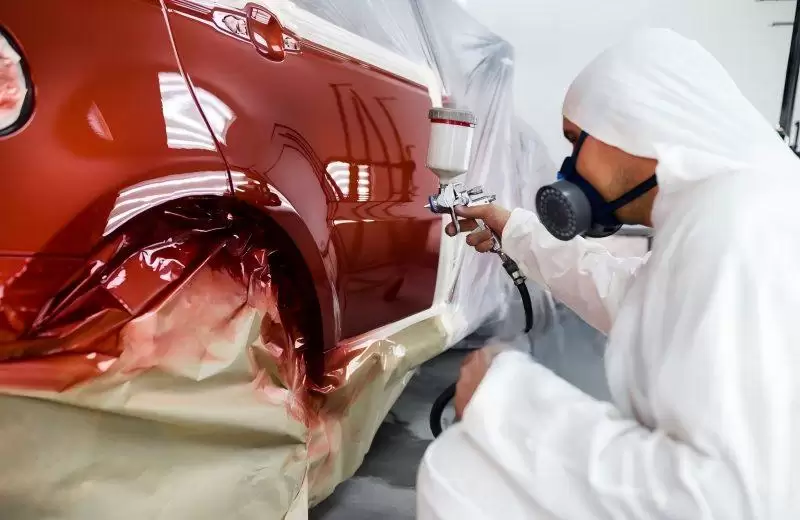
You've just put the final coat of paint on your car, your custom furniture piece, or that vintage cabinet. You're waiting for it to dry, imagining the perfect, crisp line you'll get when you peel off the tape. But when you do, your heart sinks. Instead of a clean reveal, you're left with a sticky, gummy mess. The tape's adhesive has melted into your fresh paint, ruining hours of work.
If this has happened to you, you're not alone. And the problem usually isn't your skill—it's your tape.
The Unseen Culprit: Heat
Most standard crepe masking tape, the kind you might grab for a quick indoor wall project, is just not built for tough jobs. Its adhesive has a low tolerance for heat. When you're spray painting, working in a hot garage, or your paint cures and generates its own heat, that adhesive softens. It essentially fuses itself to your project. What you need is a strategy, and that's where knowing your tape colors and types comes in.
Not All Tape is Created Equal: A Quick Guide
Walking down the aisle at the hardware store can be confusing. Why so many colors? Each one usually signals a different purpose.
• Blue Masking Tape: This is your good, all-purpose tape. It's great for basic painting on walls and has low-tack adhesive that's less likely to pull up delicate paints. But for high-heat situations, it might still struggle.
• Green Masking Tape: Often a step up, this tape usually offers stronger adhesion and better chemical resistance, making it a common choice for tougher exterior or smoother surface jobs.
• Black Masking Tape: Here's where things get serious. Black masking tape is frequently engineered specifically for extreme conditions. It's a heavyweight vinyl masking tape designed to withstand harsh weather, UV light, and most importantly, high temperatures. It's a top choice for automotive and industrial applications.
The Right Tape for the Right Job
Understanding the different materials is key to avoiding disaster.
• Washi Masking Tape: Made from Japanese paper, washi tape is fantastic for arts and crafts. It's decorative and delicate, but it's not the tape you'd use for protecting a car fender. It lacks the strength and heat resistance.
• Vinyl Masking Tape: Tapes like the black masking tape mentioned earlier are often made with a vinyl backing. This makes them exceptionally strong and durable. A high-quality vinyl masking tape is your best bet for creating sharp, razor-sharp lines on complex curves and surfaces in automotive work because it resists paint bleed and can handle the heat.
• Waterproof Masking Tape: While not always heat-resistant, a true waterproof masking tape is essential for outdoor projects exposed to rain or dew. For a project that needs to withstand both moisture and heat, you'll need to look for a tape that specifies both properties.
The QKD Difference: 15+ Years of Getting It Right
This is where experience matters. For over 15 years, we at QKD have been helping professionals and DIYers tackle their toughest projects. We've seen what happens when the wrong tape fails, and we've engineered our products to prevent it. Our range of high-temperature vinyl masking tape and specialized black masking tape is built on a foundation of solving real-world problems, not just selling a product. We know that a perfect finish depends on the tape you apply before you even open the paint can.
Your Action Plan for a Flawless Finish
So, how do you make sure you're safe?
1.Assess the Heat: Are you spray painting? Is the project in direct sun? Will the paint be baking or curing? If the answer is yes, standard crepe masking tape or basic blue masking tape is a risk.
2.Choose a Warrior, Not a Worrier: Invest in a tape designed for the challenge. Look for terms like "high-temperature," "automotive-grade," or "heat-resistant" on the label. Our QKD professionals always recommend our premium black masking tape for the most demanding heat scenarios.
3.Test First: However confident you are, always do a test strip on a scrap piece or an inconspicuous area. Apply the tape, paint it, and let it cure. Then, make the big reveal. This small step can save you a huge headache.
Don't let a few dollars' worth of tape ruin a project you've invested hundreds in. Choosing the right protection isn't just a step in the process—it's the insurance policy for your perfect finish. Trust the experience behind the QKD name to deliver the results you need.
